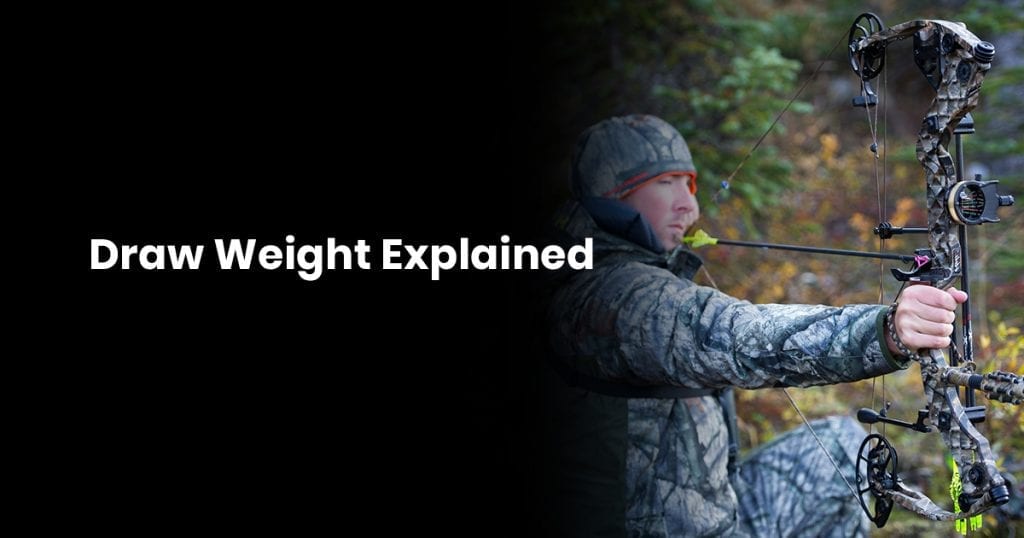Draw weight is a measurement you’re going to see whenever you search for a bow to purchase, or look up any article about beginning archery.
It’s everywhere, because it’s critical to your performance.
Everyone has a different draw weight that they should be using, and beginners should be on the lower end of that scale.
Let’s first talk about what draw weight really is, and how to calculate it.
What Exactly is Draw Weight, and Why Does it Matter?
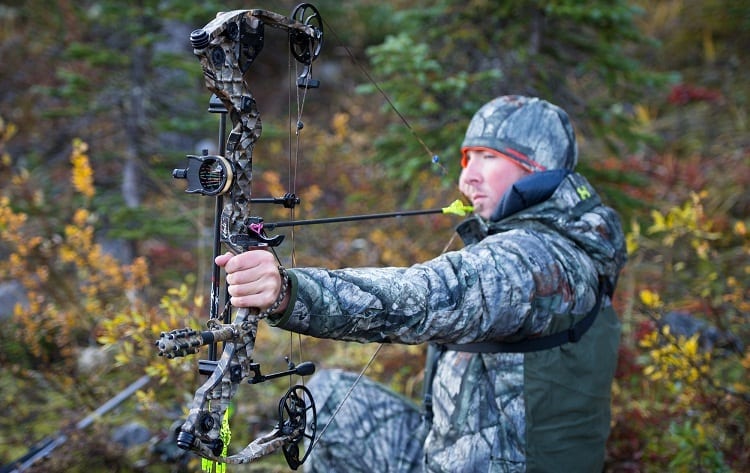
Draw weight is the measurement of how much pressure (in pounds) is required to pull a bowstring all the way back for arrow release.
It’s basically the grade of bow you have, and defines how much power you can expect from the output, and at what speed.
If you have a 30 lb draw weight on your bow, then you can only fire so far.
The draw weight, arrow weight (measured in grains), and draw length will all define the speed of your arrow, but draw weight is the most important.
You can have a low draw weight around 25-35 lbs, but still have a high draw range of about 30” or so. There are so many factors that go into it.
It matters strictly because it’s a measurement of the bow’s capabilities.
You’ll see a lot of hunting bows with a 70 lb maximum draw weight and a 28” or 31” draw length.
That means that it’s just about as powerful as a human can muster, and you can expect to see high FPS and KE ratings, which we’ll get into in a moment.
The point is, there are a ton of factors that go into your total FPS and power, but the most calculable and important one is draw weight.
What Are FPS and KE?
FPS stands for feet per second, and KE stands for kinetic energy.
The feet per second is simply a measure of distance.
You are expected to be within a football field of your target, and most FPS in beginner to moderate bows will be around 150-165 FPS, giving you a rough 1.8-2 second span between release and impact on your target.
However, kinetic energy is used to define something else entirely.
It’s used to figure out damage on impact, using the arrow’s speed, or FPS, and its weight (measured in grains).
Kinetic energy is power that’s stored in a moving object or body, and it will eventually run out.
It’s the energy that allows something to keep moving past the point of its initial push or pull to movement.
For some context, a windmill uses kinetic energy: the initial push from the wind, and the movement that continues from momentum after the wind has settled.
FPS and KE work in tandem to calculate the speed and damage, or penetration level and depth, of an arrow.
They will be defined by the draw weight, which brings us full circle.
How do You Calculate Draw Weight?
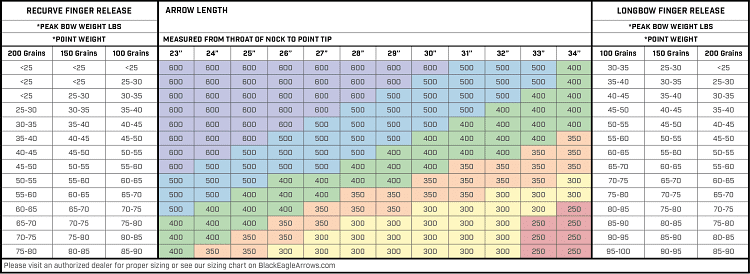
We know your draw weight is important, but now it’s time to figure out what your own draw weight is.
Archery has a moment before the release where the world slows down, and it’s just you and that bow: you calculate FPS, KE, distance, your draw weight, and rapidly predict the way this individual release will go based on the information that’s literally at your fingertips.
In short, calculating your own draw weight is very important. It’s not feasible to sit down every single time and figure out the mathematical equations, so there are two main ways you can do it.
First and foremost, you can look at the limitations of your bow.
A compound bow is going to be easier to pull back than a traditional or takedown recurve bow, so each bow will give you a different feeling of resistance even if they create similar draw weights.
If the limit of your bow is 40 lbs of draw weight, and you’re able to pull the bowstring back as far as possible (knowing that your strength capabilities exceed the limit of the bow draw weight), then you’re found the max: you’re at 40 lbs draw weight, and you know what it feels like.
Now, pull the arrow back so that the bowstring is barely even bending.
That’s probably around 0.5 or 1 lb of draw weight. Gently pull back until you reach the maximum draw weight, and feel out the bow and its resistance along the way.
You’ll know you hit the end when the resistance cannot be pushed past (though do be careful with recurves and putting too much pressure on the limbs).
That’s the “natural” way to figure it out. Over time, you’ll get a feel for this anyway, and it will help you out immensely when determining your trajectory.
The second method is more calculated, but not very invasive.
It doesn’t require you to sit with a protractor and grid paper and figure it out on a draft table over to the side. You can buy a draw weight puller, known as a bow scale, and pull back until you feel comfortable.
There will be two scales on the handle, one for the maximum draw weight (the highest that it can go), and another that pushes it into place.
When you release, you will see the latter scale return to zero, since it’s an active draw weight measure.
The other will stay in place until you realign it, but it will tell you what your draw weight was. Match that to the resistance you received and the amount that the bow was pulled back, and work from there.
What is the Best Draw Weight for Beginners?
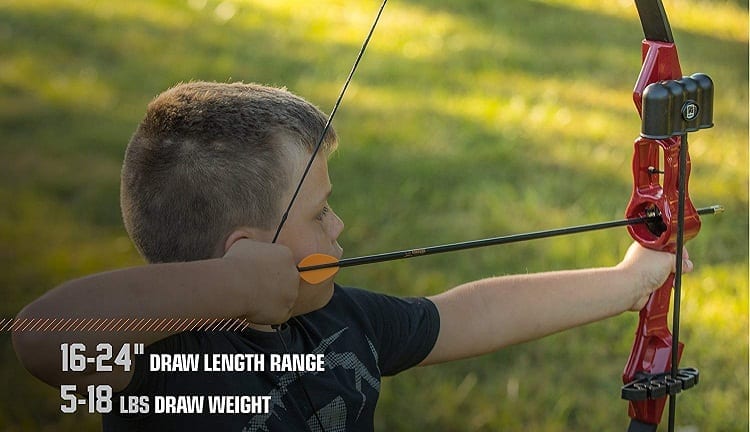
Around 25 to 30 lbs.
Draw weight is a marker of physical prowess and experience.
It’s not common to work out all the muscle groups that you use in archery from other activities.
As you gain experience and work those muscle groups, you’ll be able to work your way up to higher draw weights, and higher power.
The biggest thing to watch out for is over confidence.
People like to think that it’s just pulling a string back, that they can just start at a higher draw weight because they’re strong.
Well, it’s not a good idea. It’s a quick way to get frustrated and stop archery altogether.
Muscle groups that you will train from archery include the deltoids in your shoulders, biceps, triceps, wrist muscles, core, and obliques.
It sounds like a lot for just pulling back a string, but once you feel that resistance kick in while you’re holding your core tight, it’s all going to make sense.
No archer, beginner or expert, pulls the bow back and releasing immediately.
This isn’t Lord of the Rings. You have to hold onto that resistance for a while before finalizing your decision on release, and that’s 5-15+ seconds of engaging these muscle categories.
Eventually, you’ll be able to pull back and raise your bow quickly, and you’ll feel far less resistance; that’s a good indicator that you can move up to the next bracket of weight draw ranges.
What Should my Bow Draw Weight Be?
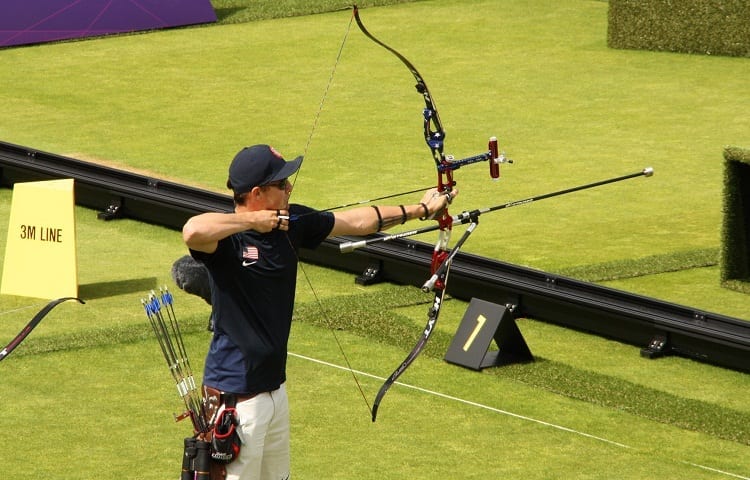
It’s relative to your body weight, so it’s not something that you can just exceed because you want to.
Draw weight has to be aligned with draw length, and you can’t make your arms longer to achieve a better draw length.
This is a quick and easy guide to draw weights and bodyweight/height.
| Average Weight | Draw weight |
| 40 lbs – 70 lbs (child) | 15 lbs max |
| 70 lbs – 100 lbs (teenager) | 20 lbs max |
| 100 lbs – 140 lbs (women/teens) | 40 lbs max |
| 140 lbs – 160 lbs (large frame) | 50 lbs max |
| 160 lbs – 190 lbs (average men) | 65 lbs max |
| 190 lbs – 220 lbs+ (large men) | 70 lbs max |
If you have a frail build and you are starting archery in the third tier, 40 lbs max draw weight might be too much to start off.
You can find bows with a 20-25 lbs max draw weight to start on and get used to.
You’ll be able to get a feel for how the draw weight and range affects your shot, and work those muscle groups to get up to your category.
Alternatively, if you are extremely tall, there are some bows that exceed 70 lbs max draw weight, but those are considered illegal in some areas (for hunting and public land practice as well).
You would have to be in a high percentile for lean body weight and height to even consider having the physical prowess to exceed 70 lbs max draw weight.
Draw Weight Dictates Performance
You can upgrade your draw weight with time for better performance and a stronger release, but don’t over-draw yourself.
You need to build up the necessary muscles and endurance to use higher draw weights, and with enough practice and dedication to learning archery, you’ll be there in no time.
Drawing weight is an important factor to consider when using compound bows. Competitive archery requires a certain level of draw weight to achieve optimal performance. Bow hunters also need to choose the appropriate draw weight for their specific needs and extreme circumstances they may experience.
Different bow types have different minimum requirements for draw weight. It is crucial to maintain proper form when drawing a bow to avoid injury. The long bow, for example, requires a higher draw weight compared to other bow types. The full draw is the point at which the bowstring is pulled back to its maximum extent.
When selecting a hunting bow, it is essential to consider the draw weight that suits your needs. The modern compound bow allows for a higher draw weight compared to traditional bows. A single shot with a high draw weight can be more effective than multiple shots with a lower draw weight. It takes a long time to develop the strength and technique required to handle higher draw weights.
When it comes to draw weight, it is important to consider factors such as arrow speed and wind speed. These factors especially the speed of your arrows can greatly affect your accuracy and overall performance during target practice. A standard bow typically has minimum draw weight requirements that you should meet in order to have enough power for your shots. If you plan on hunting larger game, like deer hunting a good thing maybe a bow with a higher draw weight
A traditional bow, commonly used in the United States, also has a specific draw weight recommendations. It is crucial to choose the right draw weight for your specific type of archery. Remember, it may take much time to build up to using a bow with much draw weight, so be patient and practice regularly.
In order to determine the appropriate draw weight for your needs, it is recommended to consult reliable sources such as Wikipedia. These sources can provide empirical evidence and scientific information to guide your decision-making process. By considering the various factors involved, you can make an informed choice that aligns with your archery goals.
When selecting good bows, it is important to understand that draw weight plays a significant role in the performance of your arrow shots. A bow with too little draw weight may result in insufficient power and accuracy, while a bow with too much draw weight can be difficult to handle and may lead to fatigue or injury. Finding the right balance is key.
Different types of archery require different draw weights. For example, target practice typically requires lower draw weights compared to hunting or competitive shooting. It is crucial to assess your specific needs and goals before determining the appropriate draw weight for your bow.
Today’s Bows, New Bow and Type of Bow
The draw weight of a bow refers to the amount of force required to pull back the bowstring. Southwest Archery Spyders are known for their versatility and adjustable draw weights. The bow’s draw weight affects the bow’s speed and power.
Traditional archery enthusiasts often prefer lower draw weights for a more challenging and authentic experience. There are better ways to improve your hand-eye coordination when shooting a bow. A good compound bow or the best recurve bow can provide a smoother and more consistent shooting experience. It is important to choose the right draw weight for your hunting season and size of the deer, such as whitetail deer.
Even a little bit of increase in draw weight can significantly impact the performance of a bow the first time. The rigidity of the limbs plays a crucial role in the draw weight and overall performance of a bow. Carbon arrows, which are good arrows are commonly used with bows of higher draw weights. Bows with higher draw weights are suitable for hunting large game.
When hunting small game, a lower draw weight can be sufficient as the target is smaller and requires less force to penetrate. However, when hunting larger game such as mule deer, a higher draw weight is recommended to ensure a clean and ethical kill. It is crucial to always prioritize the spirit of the hunt and practice responsible hunting techniques.
Before engaging in any archery activities, it is essential to warm up properly and stretch your muscles to prevent injuries. Archery injuries can occur if the draw weight is too heavy for your skill level or if you have improper form. It is advisable to seek guidance from a qualified instructor to ensure proper technique and minimize the risk of injury.
When practicing archery, it is beneficial to use a hay bale for target shooting to absorb the impact of the arrows. This helps protect the arrows and prolong their lifespan. Additionally, using a target allows you to assess your accuracy and make necessary adjustments to your form and aim especially over longer distances.
While video games may provide a simulated archery experience, it is important to note that they do not substitute for real-life practice and experience. To become proficient in archery, it is crucial to engage in regular physical practice and develop your skill level through hands-on training.
If you are interested in bow hunting, it is essential to obtain the necessary bow hunting license and permit as required by your state laws. Bow hunting licenses are typically separate from firearm licenses and may have specific requirements and regulations. It is important to familiarize yourself with these laws to ensure compliance and ethical hunting practices by avoiding animal cruelty, so please take proper care.
Remember, archery is a skill that requires practice and dedication at the end of the day. Your skill level will improve over time with consistent training and proper technique. It is important to set realistic goals and track your progress to stay motivated and continue to develop your archery abilities.

